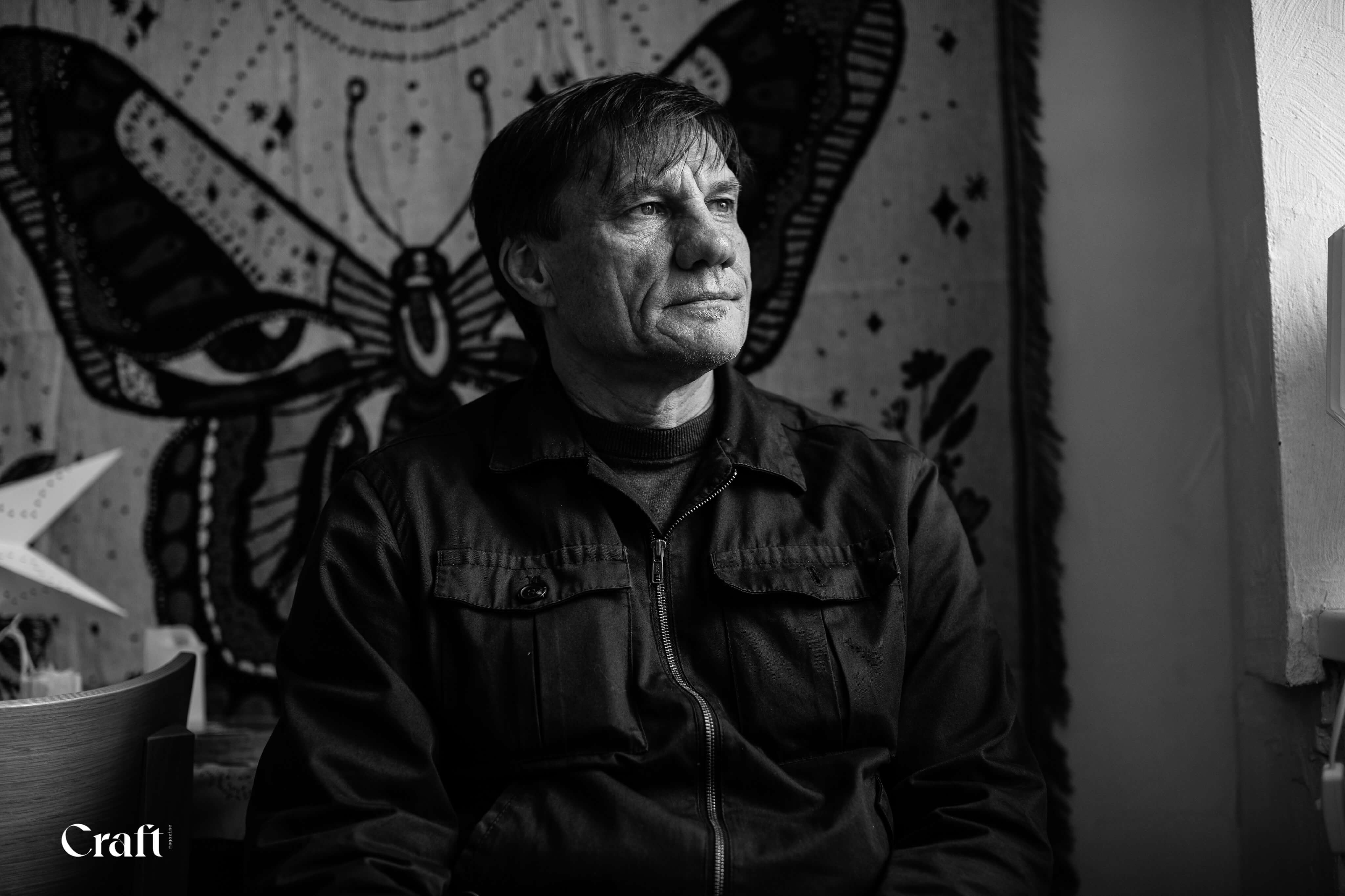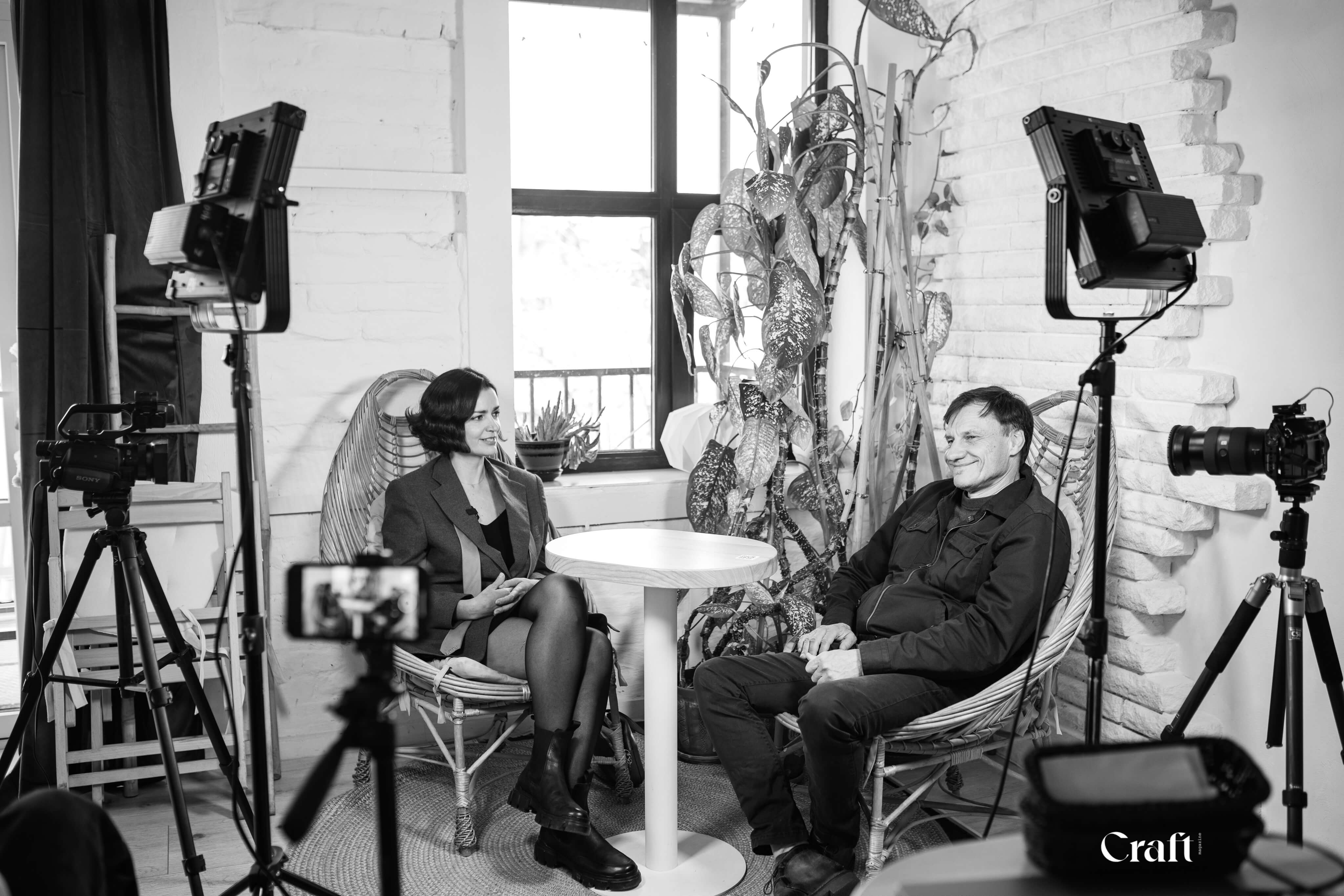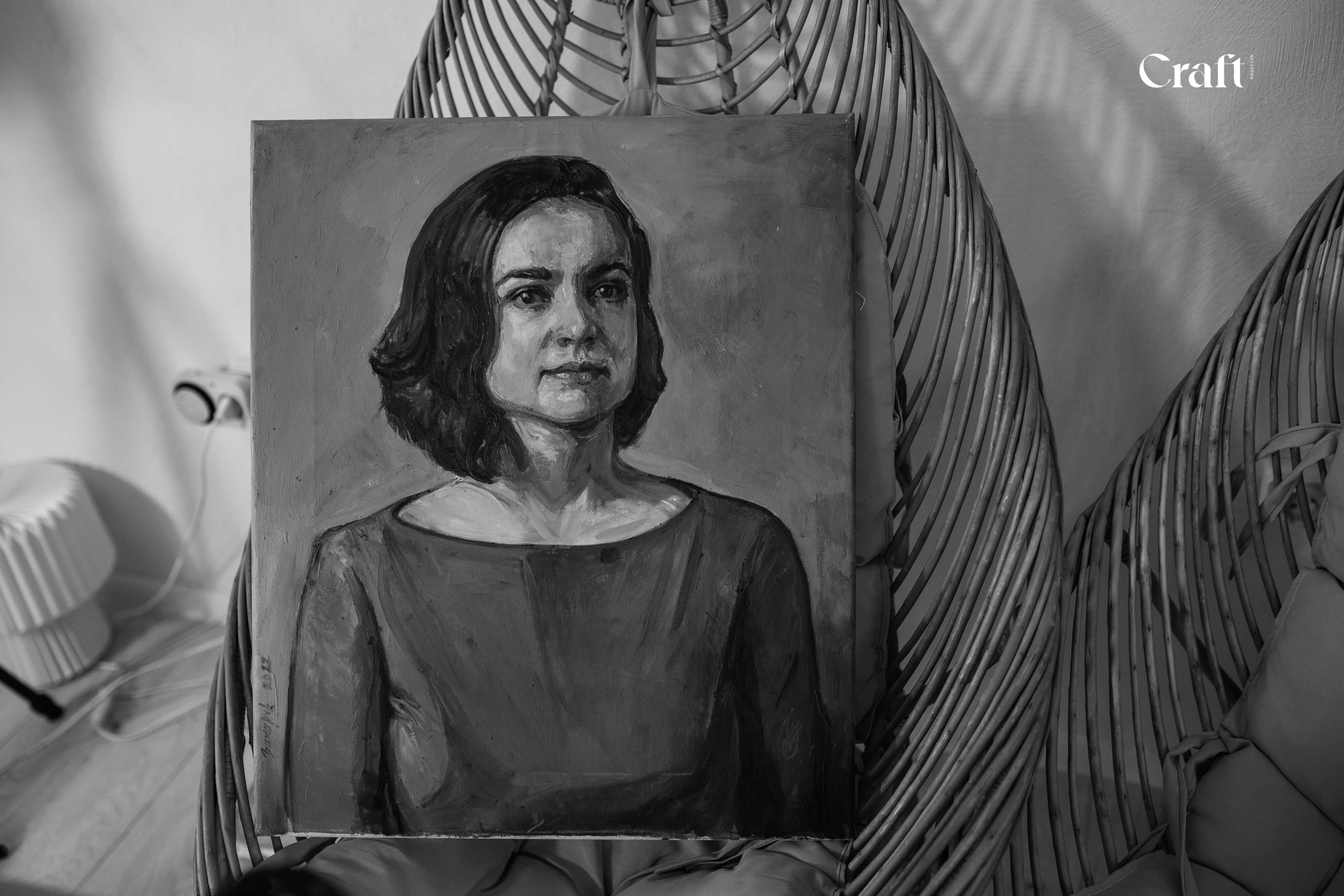Serhiy Zakharov is a Ukrainian artist and art performer from Donetsk. In 2014, he founded the “Myrzilka Art Group” in Donetsk. He placed street art works on the streets of the occupied city that mocked the so-called “DNR” militants. Because of this activity, he was imprisoned in torture chambers, where he endured severe beatings, torture, and staged executions. The events and experiences of those days culminated in his graphic novel The Hole. He currently lives and works in Kyiv.
Craft: Has your perspective changed since the start of the full-scale war?
Serhiy Zakharov: I can say that we were more expecting it than… You know, when you come from an occupied territory, you arrive—let’s say, like people now coming to Europe and saying, “There’s a war.” For those Europeans, it’s something exotic, something distant—they still don’t understand that it’s a threat to them too. And a very big threat. It’s the same feeling as when you came to Kyiv back in 2014, and life here was different. They’re interested in listening, yes, they’re curious—like how we all enjoy horror stories—they want to know what’s happening, but they’re not really trying it on for size. Most of them, at least, aren’t imagining what could come next. And when that “what comes next” actually happens, unlike, say, someone from Kyiv or another city, you already have some sense that it was bound to happen. So it’s not as much of a shock. It feels inevitable, yes.
But from the artist’s perspective… It’s a very individual perception, and everything the artists say, they say about themselves. And when you look back at past times, maybe your youth, your younger years, you realize that you were under occupation even then, just a Soviet occupation at that time. And even then, you were trying to see the world with different eyes.
Speaking of different eyes—that’s a current theme for me. I just had my vision fixed—I used to only see with one eye, and now I have 60% vision, which is a big plus. But it turned out there’s one thing—it’s congenital, and it can’t be corrected. I see everything a bit wavy, like Hundertwasser architecture, or Gaudí. And today one artist told me: “Well, you could monetize that!” So it’s a kind of specific vision. Okay, that’s about optics—but it’s physical optics.
Lyuba said that now you no longer feel alone, because this affects everyone now. But I’d really rather Europeans didn’t understand us—I mean, I’d rather it didn’t come to that. Because in some way, we’d feel a kind of satisfaction, conditionally speaking, that finally you understood what we were talking about. But God forbid that happens. What we’re doing—knocking on doors, telling the story—that’s fine. Of course, an average European might not always feel comfortable—just like anyone, in everyday life—when someone keeps bringing up their suffering. They might not really want to hear it. But we still have to speak. Right now, in fact, I’m working on a project about captivity—telling that story.
Lyuba Yakimchuk: Do you have a title for the project yet?
Serhiy Zakharov: Not yet. But we’ve agreed there will be five stories to start. So—we’re doing what we can. It’ll bas they call it—a graphic story. A graphic novel or a graphic narrative. Something like that.
And about the earlier question, something about optics. There’s this state you’re in, say, on the first day of the full-scale war. Even though, as I said, we were more prepared than others, still, in those first minutes, first moments, you walk into your studio, you look at your paintings, and it all just feels empty. What is this even about? What does this mean? What’s the point of it? The only kind of art that feels relevant at that moment is the art of killing Moskals. Everything else—it feels meaningless. I was in a kind of stupor. For about a week, I didn’t know what I could do. I couldn’t draw. I just couldn’t. Then that passed. And you go back to it anyway, because—whether it sounds pretentious or not—culture is what forms a nation. If there’s no culture, then there’s no nation.

Lyuba Yakimchuk: Yes, that’s how we define ourselves—through our culture, our identity.
I'm also working on a book, which is partly related to captivity. About a year and a half ago, a soldier who had been in captivity in Olenivka wrote to me. He had been at Azovstal in the AZOV battalion. He wrote just to thank me for my book Apricots of the Donbas, which he had flipped through at the First Bastion, right after his wife was killed. He's from Donetsk, and that book felt like home to him—something familiar. I met with him, he shared his story with me, and after our conversation, I decided to write a book. Now I have stories from over a dozen soldiers, and I'm constructing a narrative—reconstructing what happened at Azovstal, in Mariupol, to the soldiers, but also to civilians, and in Olenivka as well. And actually, in all these stories, there’s a lot of life-affirming energy. Even at Azovstal, despite the constant bombardment: KABs, sometimes three-ton bombs, the horror of it all—they joked, they used irony. There are so many stories about how irony and humor helped the soldiers keep going.
Serhiy Zakharov: When I interview former prisoners of war, I also always ask them to share something funny. And there are always such stories—even in those horrific conditions—they recall something ironic or amusing, something they joked about. Just recently, I was giving another interview, telling my own story, and someone said to me: “You're describing terrible things, but at some point, you're smiling and speaking in a joking tone.” And I said, “Look, I’ve spoken with many people who were in captivity—you could listen to anyone, like Maksym Butkevych or the late Kozlovsky—and when they talked about it, it was never with sheer anguish. There was always space for a joke, for a bit of irony.” And I think this isn’t so much a deliberate analytical technique, it’s more of a natural defense mechanism that kicks in. Do we choose it? No. But it comes out of us anyway…
Craft: Are you integrating a specific locality into your creative work now?
Serhiy Zakharov: I’d say visual art has its own niche—it’s more metaphorical. You can often trace something back to the artist’s background. For example, you look at a work and start to wonder: why does it feel this way? Then you find out the artist was born there, lived there, spent time in that place at that moment in history. And suddenly it clicks for you. You realize, “Ah, this person is from Donetsk or from Luhansk,” for example. Even if there are no direct symbols, the place is still present in the work. There’s a fine line between straightforward propaganda—even if it’s visual—and art that’s more layered. So no, I don’t consciously draw slag heaps. They might appear, but it’s not intentional.
Lyuba Yakimchuk: But see, you grew up within certain coordinates—in a particular kind of space. Lots of open steppe, a city with wide avenues. You go to Lviv, for me personally, it always feels cramped there. Because Luhansk, Donetsk, that regions—it’s all about wide streets, broad boulevards. It’s a steppe mentality, a steppe way of experiencing space. It’s different. And that’s still inside us, whether we realize it or not. I always measure everything against that early experience. That’s my axis, my zero point. Maybe not everyone does that, but I always do.
Serhiy Zakharov: Childhood trauma doesn’t just go away.
Lyuba Yakimchuk: I wouldn’t call it trauma—it’s more like a formative experience.
Serhiy Zakharov: What I mean is, I was born next to a steel plant, right in the center of the city. For me, any patch of nature—like a forest or just something green and not reeking like a plant—seemed like a miracle. I thought those places only existed for vacation. And then, when you travel to “old Europe” and you see places where birds are singing and rabbits run around in the city center, you’re stunned. You think, wait, this is possible?
Lyuba Yakimchuk: Yeah, I get it. But for me, factories are beautiful. Mines are beautiful.
Serhiy Zakharov: There’s definitely a kind of aesthetic to them. There is.
Lyuba Yakimchuk: When you're leaving Kyiv’s central railway station and you pass by that smoking plant—for me, that’s beautiful. I don’t know, some people are horrified by it.
Serhiy Zakharov: No, for me, it’s like a set of markers I can latch onto and admire.
Lyuba Yakimchuk: Same for me. I grew up near a slagheap—when the trees had no leaves, you could see it right from our yard. And in the '90s, when I was a kid, it used to smoke. And it was beautiful.
Serhiy Zakharov The slagheap I grew up next to was so old, it had already grown over. It didn’t even look like a slagheap anymore—it wasn’t smoking, it had passed that stage. It had become more like a natural hill.
By the way, that slagheap—I’m talking about 2014, when the city was already infected with the “russian world” ideology. It was the beginning of the occupation—Strelkov hadn’t entered the city yet, but there were already local fanatics, backed by russians who had “come to help,” organizing the so-called referendum, and so on. And at that time, we were exchanging visual symbols. I was doing my street art, and when I went outside, I’d see stencils on the poles—someone had painted tridents. And on that very slagheap, someone would hang up a Ukrainian flag. And it was incredibly important—to wake up in the morning and see the Ukrainian flag on your slag heap. Then it would get torn down. And then someone would hang it up again. That exchange of signs and symbols really mattered.

Lyuba Yakimchuk: It was the same in Luhansk.
Serhiy Zakharov: It was both deeply important and strangely comforting. That kind of comfort that’s possible when the world around you is falling apart before your eyes.
Lyuba Yakimchuk: Tell us—how do you paint now? What do you feel when you're working on a piece?
Serhiy Zakharov: Well, I’d say the feeling I get now is the same one I’ve had since childhood, since I realized I was an artist. Visual art is a bit different from literature and the fields connected to it, like theater, film, and so on. I often talk to people who are incredibly intellectually developed. They know cinema, music, and literature inside out. But whenever the conversation shifts to visual art, there’s often a bit of a gap. That always surprised me. Recently, though, I finally got an answer in a conversation. It’s because in literature and those other fields, there’s a guide—the author—who takes you by the hand and leads you through the experience. But in visual art, the artist isn’t a guide. The artist gives you the material, and you’re the one who has to work with it. To truly engage with and enjoy visual art—to really feel that thrill—you need self-education. It takes effort, personal development.
I remember art school where we did learn about art history. Of course, the “correct” and “most important” school of art was, naturally, Socialist Realism. They showed us examples of “decadent Western art” and told us how degenerate and terrible it was. But it had the opposite effect. You’d look at all these Western artists and think—wow, this is amazing. So in a way, it worked in reverse. At least they showed it to us. And that was enough to spark interest, to capture your imagination, even back then.
If we’re speaking broadly, Ukrainian art does carry weight. In fact, sometimes you notice a kind of advantage—because a lot of what’s exhibited on Western platforms has become a bit like chewing gum: something that doesn’t really lead anywhere, offering only surface-level aesthetic pleasure, just some colorful blotches. But our art has substance. It has depth. The problem is, we just don’t show enough of it. And there’s another issue—this trend of showcasing work that’s, frankly, amateurish or poorly made. You know, things like flags and tridents slapped on without much thought or craft. This kind of art gets carted around to say, “Look, we’re fighting, we’re resisting.” But to me, that kind of thing does more harm than good.
Recently someone asked me, “So how do you express your hatred of the enemy in your work?”
I was a bit caught off guard at first. But later, I realized a simple and clear thought: even if you’re painting, say, a flower—just beauty itself—that is, in fact, an act of defiance. That is disdain for the enemy. It’s a sign that we are alive, that we see beauty, and that we will live this life and still take joy in what is truly beautiful. I didn’t say that at the time—I was too flustered. But that’s what I wish I had said.
Lyuba Yakimchuk: If we talk about flowers—look, they name their missiles after flowers. They have all sorts of weapons named Hydrangea, Gerbera. But we have a garden. A real, living garden.
When I finally returned to my art, it felt vital to gather people. We had this little basement on Yaroslaviv Val Street—the people who stayed in Kyiv would meet there. Because Kyiv was quite empty then. And the people who remained—they were holding the city. I painted portraits of friends.

It became a kind of informal series—Portraits of Friends. But these weren’t just portraits in some neutral moment. These were made in an extremely critical, intense time.
Lyuba Yakimchuk: And the basement was actually great. You couldn’t hear the air raid sirens down there.
Serhiy Zakharov: And the best part—it always had electricity. Having light— hat was so important.
Lyuba Yakimchuk: Especially for an artist. And a writer.
Serhiy Zakharov is a Ukrainian artist and art performer from Donetsk. In 2014, he founded the “Myrzilka Art Group” in Donetsk. He placed street art works on the streets of the occupied city that mocked the so-called “DNR” militants. Because of this activity, he was imprisoned in torture chambers, where he endured severe beatings, torture, and staged executions. The events and experiences of those days culminated in his graphic novel The Hole. He currently lives and works in Kyiv.